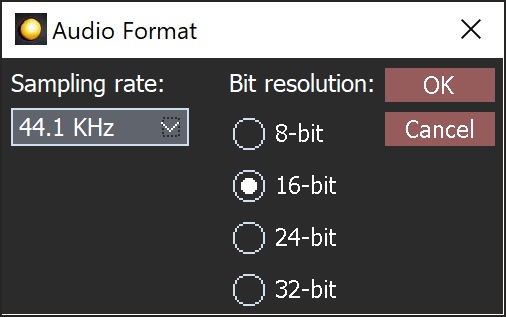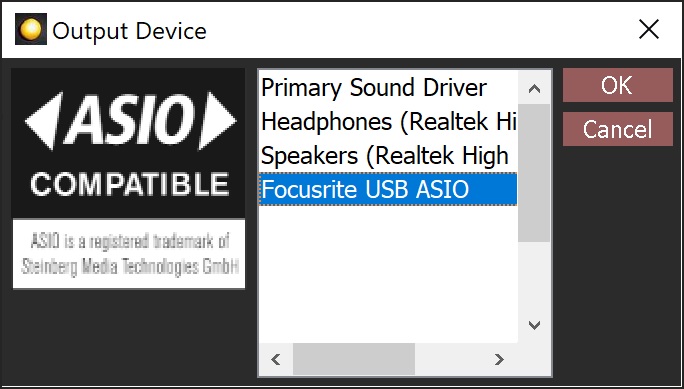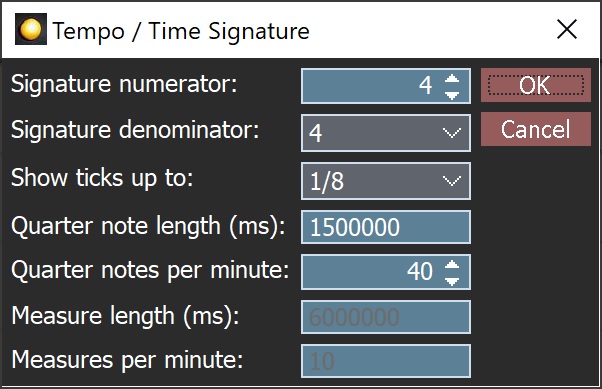Orinj version 9.0.0
A session in Orinj is the collection of tracks, wave files, MIDI files, loop files, effects, volume and pan settings, and other settings that make up your song – your recording session.
Sessions are managed in the Orinj multitrack session view. All of what you can do in this view controls either your session or individual components of your session, such as tracks, wave files, and effects. To gain a more complete understanding of sessions, see also Orinj Working with session tracks, Orinj Working with session blocks, and Orinj Working with effects.
Create a new session
To create a new session, click on File and then on New in the multitrack session menu. When you do so, you will get the following dialog.

Specify the sampling rate and sampling resolution for your new session in the dialog and click OK. New waves recorded in this session will have these sampling rates and sampling resolutions. Wave files inserted into the session, if with a different sampling rate, will be converted to a wave file with the session sampling rate. MIDI files and loops inserted into the session will be mixed to wave files with the session sampling rate and sampling resolution.
View the audio format of a session
To see information about the sampling rate and sampling resolution of the current session, click on Session and then on Audio Format in the Orinj menu.
Save a session
Click on File and then on Save or Save As in the Orinj menu.
Sessions are saved to files with the extension "kal". The session file on your hard drive contains all information about the session, except for actual sound data. That is, a session file contains session parameters, such as effect settings, track volumes, and other, but only points to the wave, loop, and MIDI files used by the session. If you delete a wave file that the session points to, you can still work with that session, but the sound data that existed in this file will be lost and you will not be able to use it in your session.
Open an existing session
To open an existing session, click on File and then on Open. Browse to your session and open it.
Click on File and then Recent in the Orinj menu to see recently used sessions. Click on one of those sessions to open it.
Choose an output device
Orinj uses a single device for sound output for the whole session. To choose the output device, click on Session and then on Output Device. You will see the following dialog.

Typically, the "primary sound driver" device will be the default sound device chosen through your operating system. Select a device in the dialog and click OK.
Set the tempo / time signature
To set the tempo and time signature of your session, click on Session and then on Tempo / Time Signature. You will see the following dialog.

Orinj does not make sure that your recorded files and inserted files are on beat. You can, for example, import a 4/4 loop with quarter notes of 500 milliseconds in a session with 3/4 signature and quarter notes of 600 ms.
It is not necessary to set the tempo and time signature to record a complete song. Setting those makes the time signature line at the top of Orinj consistent with your song and with the time line. This may make recording and modifying your song easier. It will be easier to move and cut waves, for example, as waves will snap to the time signature line (see Orinj Working with session blocks and Orinj Preferences). If you also set the tempo and time signatures for each of the other Orinj views similarly (the single wave view, MIDI roll view, and loop building view), it will be easier to create MIDI and loop files with the same tempo.
Play, stop playback, pausе, fast forward, rewind
To play your session, click on the play button ( ) in the player toolbar at the bottom of Orinj, or click on Session and then on Play in the Orinj menu.
) in the player toolbar at the bottom of Orinj, or click on Session and then on Play in the Orinj menu.
To play only what is visible on the screen, click on the play screen button ( ) in the player toolbar at the bottom of Orinj, or click on Session and then on Play Screen in the Orinj menu. Once the play cursor (the yellow vertical line) reaches the end of what is visible on screen playback will stop.
) in the player toolbar at the bottom of Orinj, or click on Session and then on Play Screen in the Orinj menu. Once the play cursor (the yellow vertical line) reaches the end of what is visible on screen playback will stop.
To play a portion of your session in a loop, you must first select that portion. Then click on the play loop button ( ) in the player toolbar at the bottom of Orinj, or click on Session and then on Play Loop in the Orinj menu. To make a selection over a wave or a track, first click on the select mouse pointer (
) in the player toolbar at the bottom of Orinj, or click on Session and then on Play Loop in the Orinj menu. To make a selection over a wave or a track, first click on the select mouse pointer ( ) in the pointer toolbar at the bottom of Orinj. Then make a selection by clicking on the wave or track and dragging the mouse to the left or the right.
) in the pointer toolbar at the bottom of Orinj. Then make a selection by clicking on the wave or track and dragging the mouse to the left or the right.
To stop playback, click on the stop button ( ) in the player toolbar at the bottom of Orinj, or click on Session and the on Stop in the Orinj menu. When you stop playback the play cursor (the vertical yellow line) will return to where playback started.
) in the player toolbar at the bottom of Orinj, or click on Session and the on Stop in the Orinj menu. When you stop playback the play cursor (the vertical yellow line) will return to where playback started.
To fast forward playback, click on the fast forward button ( ) in the player toolbar at the bottom of Orinj. Playback will resume when you release the fast forward button. You can only fast forward during playback.
) in the player toolbar at the bottom of Orinj. Playback will resume when you release the fast forward button. You can only fast forward during playback.
To rewind playback, click on the rewind button ( ) in the player toolbar at the bottom of Orinj. Playback will resume when you release the rewind button. You can only rewind during playback.
) in the player toolbar at the bottom of Orinj. Playback will resume when you release the rewind button. You can only rewind during playback.
To rewind to the start of the session, click on the rewind to start button ( ) or click on Session and then on Rewind To Start in the Orinj menu.
) or click on Session and then on Rewind To Start in the Orinj menu.
Record
To record, follow these steps.
- Prepare the track for recording. Click on the record button (the third of the three small buttons under the volume controls to the left of the track) in the track control panel to the left of the track. You can choose more than one track for recording.
- Select an input device for each of the tracks prepared for recording. Select a track and click on Track and then on Input Device in the Orinj menu to select the input device. Choose a sampled audio device to record sampled audio or a MIDI device to record MIDI. If you choose to record to more than one track, you can choose different inputs for each track. If you choose the same input for different tracks, these tracks will record the same sound data.
- Click on the record button (
 ) in the player toolbar at the bottom of Orinj or click on Session and then on Record in the Orinj menu.
) in the player toolbar at the bottom of Orinj or click on Session and then on Record in the Orinj menu.
Mix
To mix your session, click on Session and then on Mix To File in the Orinj menu. Orinj will mix the session into a single wave file and will load that file into its single wave view. You can then further modify that file by adding effects and so on.
See Orinj Mix order to understand the order of preparing sound data in the mix, using effects, auxiliary channels, volume, pan, and so on.
Add new comment